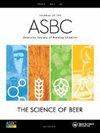Continued Exploration of Barley Genotype Contribution to Base Malt and Beer Flavor Through the Evaluation of Lines Sharing Maris Otter® Parentage
IF 1.8
4区 农林科学
Q4 BIOTECHNOLOGY & APPLIED MICROBIOLOGY
Journal of the American Society of Brewing Chemists
Pub Date : 2021-08-04
DOI:10.1080/03610470.2021.1952509
引用次数: 6
Abstract
Abstract Heirloom barley (Hordeum vulgare L.) varieties remain interesting to maltsters and brewers for their perceived unique flavor contributions to beer, despite not meeting contemporary agronomic and malting expectations. This study utilized crosses of the heirloom Maris Otter® and two contemporary genotypes to determine if “updated heirlooms” could be produced that would show improved agronomics and contemporary malt quality, while contributing uniquely to malt and beer sensory and chemical profiles. Using a recently established pipeline of malting; brewing; hot steep and beer sensory; and metabolomics to evaluate barley genotype contributions to malt and beer flavor, four experimental lines were compared to a control. The experimental lines were also assessed for their genomic contribution from their respective parents to further elucidate regions of the Maris Otter genome that may contribute to unique beer flavors. Results show improved agronomic outcomes relative to the heirloom parent and were comparable to the control. Malting quality met current recommendations. However, sensory properties attributable to the unique heirloom parent were not found. Further, chemical profiling did not explain the observed nuanced sensory differences, nor did it reveal unique metabolites not described by the sensory panels. Supplemental data for this article is available online at at http://doi:10.1080/03610470.2021.1952509.通过对Maris Otter®亲本的评估,继续探索大麦基因型对基础麦芽和啤酒风味的贡献
摘要传家乐大麦(Hordeum vulgare L.)品种因其对啤酒的独特风味贡献而受到麦芽酿造商和酿酒商的关注,尽管它们没有达到当代农学和麦芽酿造的期望。这项研究利用传家宝Maris Otter®和两种当代基因型的杂交来确定是否可以生产出“更新的传家宝”,这将显示出改善的农艺学和当代麦芽质量,同时对麦芽和啤酒的感官和化学特性做出独特贡献。使用最近建立的麦芽生产线;酿造;热饮料和啤酒的感官;为了评估大麦基因型对麦芽和啤酒风味的贡献,将四个实验品系与对照品系进行了比较。实验品系还评估了其各自亲本的基因组贡献,以进一步阐明可能有助于独特啤酒风味的水獭基因组区域。结果表明,与传家宝亲本相比,农艺效果有所改善,与对照组相当。麦芽质量符合当前建议。然而,没有发现这种独特的传家宝母体所具有的感官特性。此外,化学分析并没有解释观察到的细微感官差异,也没有揭示感官小组没有描述的独特代谢物。本文的补充数据可在线获取,网址为http://doi:10.1080/03610470.2021.1952509.
本文章由计算机程序翻译,如有差异,请以英文原文为准。
求助全文
约1分钟内获得全文
求助全文
来源期刊

Journal of the American Society of Brewing Chemists
工程技术-生物工程与应用微生物
CiteScore
4.00
自引率
20.00%
发文量
41
审稿时长
3 months
期刊介绍:
The Journal of the American Society of Brewing Chemists publishes scientific papers, review articles, and technical reports pertaining to the chemistry, microbiology, and technology of brewing and distilling, as well as the analytical techniques used in the malting, brewing, and distilling industries.
 求助内容:
求助内容: 应助结果提醒方式:
应助结果提醒方式:


